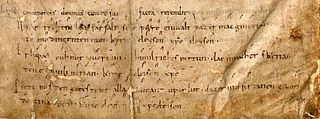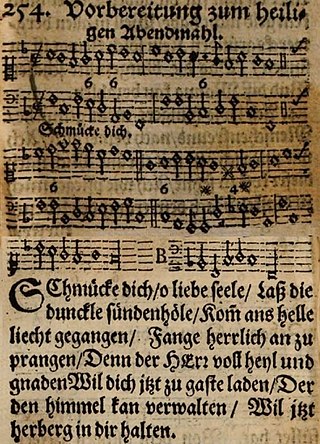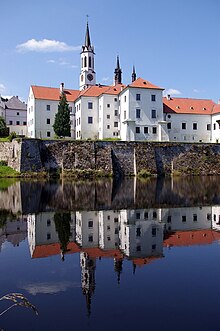Deutsche Messe was published by Martin Luther in 1526. It followed his work Formula missae from the year 1523, pertaining to the celebration of a Latin mass. Both of these masses were meant only as suggestions made on request and were not expected to be used exactly as they were, but could be altered. The function of the mass, according to Luther, is to make people hear the word.
Chorale fantasia is a type of large composition based on a chorale melody, both works for organ, and vocal settings, for example the opening movements of Bach's chorale cantatas, with the chorale melody as a cantus firmus.

"Nun bitten wir den Heiligen Geist" is a German Christian hymn. The first stanza is a leise from the 13th century which alludes to the Latin sequence Veni Sancte Spiritus for Pentecost. It was widely known, and aside from its Pentecostal origin was also used as a procession song and in sacred plays.
Michael Weiße or Weisse was a German theologian, Protestant reformer and hymn writer. First a Franciscan, he joined the Bohemian Brethren. He published the most extensive early Protestant hymnal in 1531, supplying most hymn texts and some tunes himself. One of his hymns was used in Johann Sebastian Bach's St John Passion.

"O Welt, sieh hier dein Leben" is a Lutheran Passion hymn in German by Paul Gerhardt. In 16 stanzas of 6 lines, it was first published in 1647 in Johann Crüger's Praxis pietatis melica. The hymn is known as the source for chorales in Bach's Passions. It was translated to English in several versions, for example "O, World! behold upon the tree" by Catherine Winkworth in 1858.

"Vom Himmel hoch, da komm ich her" is a hymn text relating to the Nativity of Jesus, written by Martin Luther in 1534. The hymn is most often sung to the melody, Zahn No. 346, which first appeared in a 1539 songbook and was probably also composed by Luther. This classic Christmas carol remains popular and has inspired many choral and organ works by other composers.
Jesus Christus unser Heiland may refer to:

"Jesus Christus, unser Heiland, der den Tod überwand" is a hymn for Easter by Martin Luther. The text originated in 1524. Johannes Zahn listed three hymn tunes for it. Two of these, Zahn Nos. 1976 and 1977, were published in 1724. A third, Zahn No. 1978, is attributed to Luther and was first published in 1529. Variants of this melody originated up to the early 17th century.
"Jesus Christus, unser Heiland, der von uns den Gotteszorn wandt" is a Lutheran hymn in ten stanzas by Martin Luther for communion, first published in 1524 in the Erfurt Enchiridion. It is one of Luther's hymns which he wrote to strengthen his concepts of reformation. The models for the text and the melody of Luther's hymn existed in early 15th-century Bohemia. The text of the earlier hymn, "Jesus Christus nostra salus", goes back to the late 14th century. That hymn was embedded in a Hussite tradition.

"Christe, du Lamm Gottes" is a Lutheran hymn, often referred to as the German Agnus Dei. Martin Luther wrote the words of the hymn as a translation of the Latin Agnus Dei from the liturgy of the mass. The tune, Zahn 58, was taken from an older liturgy. The hymn was first published in 1528 and has been the basis for several musical settings by composers such as Bach, Mendelssohn and Hessenberg. It appears in modern German hymnals, both the Protestant Evangelisches Gesangbuch and the Catholic Gotteslob.

The Leise or Leis is a genre of vernacular medieval church song. They appear to have originated in the German-speaking regions, but are also found in Scandinavia, and are a precursor of Protestant church music.

"Schmücke dich, o liebe Seele" is a Lutheran hymn in German, with lyrics by Johann Franck and a hymn tune by Johann Crüger. It was first published in Crüger's 1649 Geistliche Kirchen-Melodien, and was later adopted in other hymnals, such as the 1653 edition of his Praxis pietatis melica.

"Ach lieben Christen seid getrost" is a Lutheran hymn in German with lyrics by Johannes Gigas, written in 1561. A penitential hymn, it was the basis for Bach's chorale cantata Ach, lieben Christen, seid getrost, BWV 114.

"Christus, der uns selig macht" is a German Lutheran Passion hymn in eight stanzas in German by Michael Weiße, written in 1531 as a translation of the Latin hymn "Patris Sapientia" to an older melody of the Bohemian Brethren.

"Freu dich, Erd und Sternenzelt" is a German Christmas carol. The text and melody are based on the Czech carol "Narodil se Kristus pán", which was derived around 1500 from a Latin model, "En Virgo parit filium", The Czech song is regarded as a popular Czech carol.

"Christ fuhr gen Himmel" is a German Ascension hymn. The church song is based the medieval melody of the Easter hymn "Christ ist erstanden". It was an ecumenical song from the beginning, with the first stanza published in 1480, then included in a Lutheran hymnal in 1545, and expanded by the Catholic Johannes Leisentritt in 1567. It appears in modern German Catholic and Protestant hymnals, and has inspired musical settings by composers from the 16th to the 21st century.

"Das Grab ist leer, der Held erwacht" is a Catholic hymn for Easter, first printed in 1777 in the hymnal Landshuter Gesangbuch published by Franz Seraph von Kohlbrenner. Keeping only the first of five stanzas, with additional two stanzas, it appeared in hymnals of the 19th century, and later in different versions in several regional sections of the Catholic hymnal Gotteslob. It is a frequently sung hymn in Easter services.

Two Motets, Op. 74, are two sacred motets for unaccompanied mixed choir by Johannes Brahms, published together. Number 1, composed in 1877 in several movements, is Warum ist das Licht gegeben dem Mühseligen?, based on Biblical texts and a chorale. Number 2, composed earlier, is O Heiland, reiß die Himmel auf, containing different settings of the stanzas of Friedrich von Spee's "O Heiland, reiß die Himmel auf". The two motets were published by N. Simrock in December 1878 and dedicated to Philipp Spitta.














